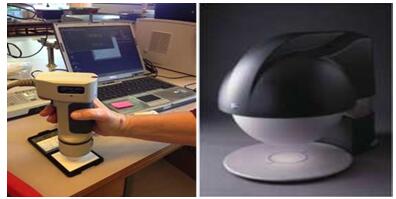品质至上,客户至上,您的满意就是我们的目标
技术文章
当前位置: 首页 > 技术文章
多光谱图像VideometerLab与色度计在肉色测量上的比较
发表时间:2017-03-16 13:31:42点击:2823
来源:博普特
分享:

丹麦DTU大学、丹麦肉品研究院与Videometer的科学家将通用的色度计与新型多光谱成像技术在肉色测量的应用上做了比较,取得了令人满意的效果.
对新鲜和加工肉的肉色测量研究显示采用多光谱成像技术,例如 VideometerLab系统,结合基于CIE标准的色彩模型,是一种有效替换标准色度计的方法。研究揭示出两种方法评估颜色的不同,特别是对鲜肉测量应用实例中。就这些样品而言,研究揭示出特殊反射会影响色度测量的色差分量,导致其与亮度分量L*的相关性增加。使用漫射照明的成像系统可考虑作为可行的替换标准测量方法的替代方案。除了对整个样品进行客观测量以及捕捉色彩差异,多光谱还有其它测量特性,如成份测量、尺寸形态测量等,在食品行业质量控制或研究领域具有多功能的优势。产品详细介绍参见链接。

A Comparison of Meat Colour Measure-ments From a Colorimeter andMultispectral Images.
C H. Trinderupa, A L. Dahla, K. Jensenb, J M. Carstensena,c, and K. Conradsena
aDTUCompute,TechnicalUniversityofDenmark,Matematiktorvet,Building303B,2800Kgs.Lyngby,Denmark
bDanishMeatResearchInstitute,Maglegårdsvej2,4000Roskilde,Denmark
cVideometerA/S,LyngsøAllé3,2970Hørsholm,Denmark
Correspondingauthor:ctri@dtu.dk
Introduction
Consumers select products based on colour, especially withfresh products, such as fruit, vegetables, and meat (Francis,1995). This choice is associated with their earlier experiences, and acceptance relies on these (MacDougall & Hutchings, 2002). Consistent and objective colour assessment is therefore important in the fields of research, product development, and quality control (Wu & Sun, 2013). Within food science the CIELAB colour space is often applied for colour evaluation. This colour space corresponds well with the colour perception by humans (León et al., 2006), which is advantageous when comparing with results of a sensory panel.
This study focuses on the assessment of meat colour. Thestandard instruments for colour measurement are colorimeters and spectrophotometers. A colorimeter is a so-called tristimulus instrument that employs filters in order to obtain colour values (Hunt et al., 1991). The colorimeter is a handheld instrument, where the operator measures a sample at a number of sites. These sites are chosen depending on the sample, e.g. to avoid meat tendons and intramuscular fat. This makes the measurements subjective and hard to reproduce (Larraín et al.,2008). Furthermore, these site measurements do not alwaysreflect the colour variation of the entire sample (Mancini & Hunt, 2005).
To overcome some of the limitation of the colorimeter we suggest using a multispectral imaging system. We map the detailed images to the CIELAB colour space using a photometric imaging model. We compare the colour assessment of our visual system with a standard colorimeter for different meat types using the CIELAB values. Unlike the colorimeter, the imaging system measures the spatial colour variation across the entire sample.
Food colours have previously been assessed using visual
systems by converting RGB images to sRGB images and then to CIELAB values (Larraín et al., 2008; Mendoza et al., 2006; Blasco et al., 2003; Chen et al., 2002; O’Sullivan et al., 2003; Yam &Spyridon, 2004). Wu & Sun (2013) emphasize that the RGB
images, amongst other issues, are dependent on the sensitivity of the camera employed, and cannot be directly transformed to sRGB in a consistent manner. As a result, the reproducibility and objectivity of the colour assessment is compromised. By applying a multispectral vision system, the advantage of more spectral information is achieved, but also the robustness and consistency that is needed for colour assessment. In addition, mapping by the photometric imaging model is a direct way of obtaining the CIELAB values. We therefore chose to use multispectral images for our colour assessment.
Yagiz et al. (2009) reported a study similar to ours ondifferences in colour measurements from a colorimeter and a RGB vision system for fresh salmon fillet colour. The study revealed that despite the fact that similar results were obtained from calibration plates for the two assessment methods, the measured colour of fresh salmon differed. The colour recorded by the vision system closely resembled the perceived colour of the fillets, whereas the colorimeter returned grayish colours.
In this study we investigated meats from livestock animalsand poultry, both fresh and processed types. Working with these two types ofproduct under the same conditions made it possible to investigate how the processing of the meat influenced the colour assessment. The basis of the analysis was a variance component analysis considering all of the possible effects influencing the colour assessment. First and foremost the analysis established that the two methods assessed the colour components differently, especially the chromatic components, a* and b*. The difference depended on the type of the sample, since the measurements of processed and fresh meat showed different behaviours. This indicated that the reflectance properties of the samples influence the colorimeter more than the multispectral vision system. The results are in accordance with the results of Yagiz et al. (2009) and support the advantages of using a vision system for colour assessment in food science.
This study on the measurement of meat colour of bothfresh and processed meat types have shown that employing a multispectral imaging system, such as the VideometerLab in combination with a colour model based on the CIE standards is a valid alternative to the standard colorimeter. The analysis revealed differences in the assessment of colour by the two methods, especially in the case of samples of fresh meat. For these samples the analysis indicated that specular reflectance can influence the colorimeter measurements of the chromatic components, giving rise to a dependency on the lightness component L*. The use of a vision system with diffuse lightning is therefore considered to be a practicable alternative to the standard measurement method. Besides offering objective measurement and capture of colour variation across a sample, it offers other possibilities that can be of advantage in quality control or research within food science.